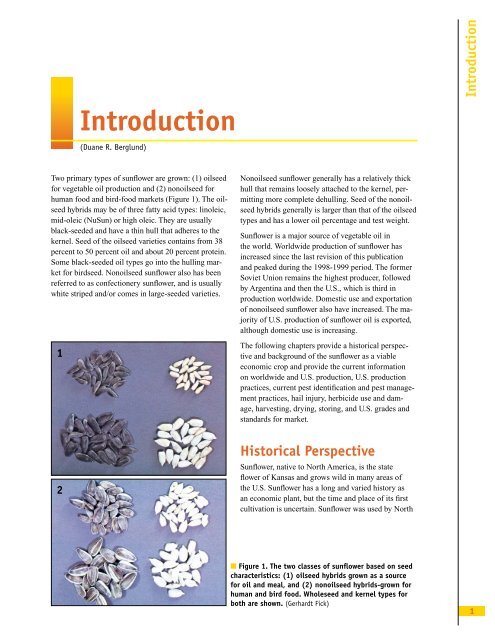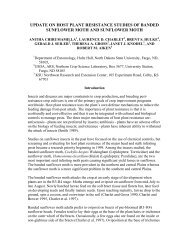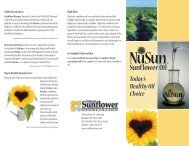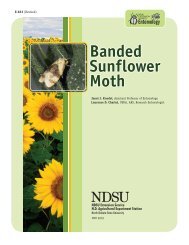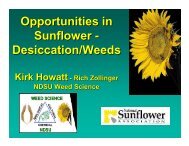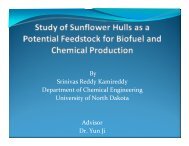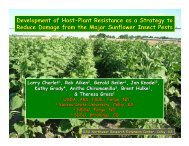Sunflower Production - NDSU Agriculture - North Dakota State ...
Sunflower Production - NDSU Agriculture - North Dakota State ...
Sunflower Production - NDSU Agriculture - North Dakota State ...
Create successful ePaper yourself
Turn your PDF publications into a flip-book with our unique Google optimized e-Paper software.
IntroductionIntroduction(Duane R. Berglund)Two primary types of sunflower are grown: (1) oilseedfor vegetable oil production and (2) nonoilseed forhuman food and bird-food markets (Figure 1). The oilseedhybrids may be of three fatty acid types: linoleic,mid-oleic (NuSun) or high oleic. They are usuallyblack-seeded and have a thin hull that adheres to thekernel. Seed of the oilseed varieties contains from 38percent to 50 percent oil and about 20 percent protein.Some black-seeded oil types go into the hulling marketfor birdseed. Nonoilseed sunflower also has beenreferred to as confectionery sunflower, and is usuallywhite striped and/or comes in large-seeded varieties.1Nonoilseed sunflower generally has a relatively thickhull that remains loosely attached to the kernel, permittingmore complete dehulling. Seed of the nonoilseedhybrids generally is larger than that of the oilseedtypes and has a lower oil percentage and test weight.<strong>Sunflower</strong> is a major source of vegetable oil inthe world. Worldwide production of sunflower hasincreased since the last revision of this publicationand peaked during the 1998-1999 period. The formerSoviet Union remains the highest producer, followedby Argentina and then the U.S., which is third inproduction worldwide. Domestic use and exportationof nonoilseed sunflower also have increased. The majorityof U.S. production of sunflower oil is exported,although domestic use is increasing.The following chapters provide a historical perspectiveand background of the sunflower as a viableeconomic crop and provide the current informationon worldwide and U.S. production, U.S. productionpractices, current pest identification and pest managementpractices, hail injury, herbicide use and damage,harvesting, drying, storing, and U.S. grades andstandards for market.2Historical Perspective<strong>Sunflower</strong>, native to <strong>North</strong> America, is the stateflower of Kansas and grows wild in many areas ofthe U.S. <strong>Sunflower</strong> has a long and varied history asan economic plant, but the time and place of its firstcultivation is uncertain. <strong>Sunflower</strong> was used by <strong>North</strong>■ Figure 1. The two classes of sunflower based on seedcharacteristics: (1) oilseed hybrids grown as a sourcefor oil and meal, and (2) nonoilseed hybrids-grown forhuman and bird food. Wholeseed and kernel types forboth are shown. (Gerhardt Fick)1


